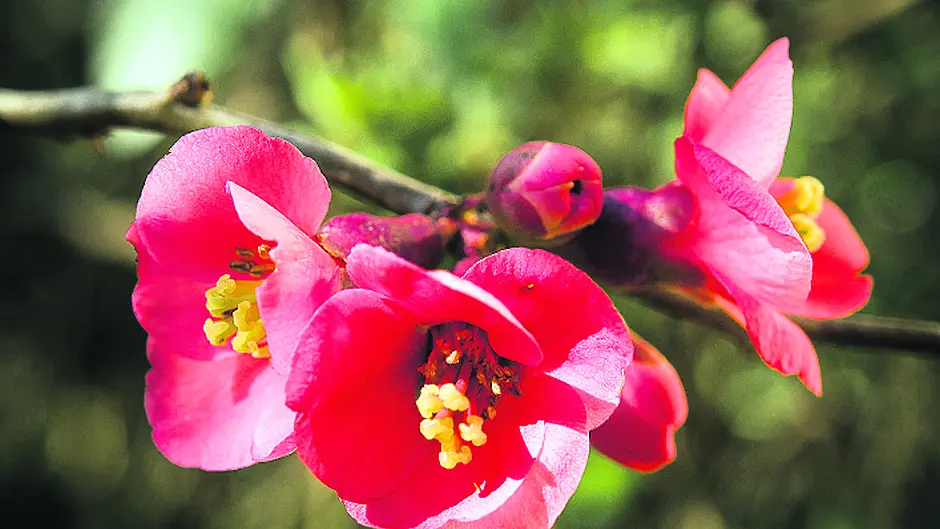The garden really comes to life in April and changes are rapid in any warm spell.
The garden really comes to life in April and changes are rapid in any warm spell. The month seems to fly by between sowing, planting and potting on. Weeds start to grow too and the lawn needs mowing more often than it has for months. If there is little time left over to enjoy the vegetables, flowers and shrubs; don’t worry — all that will come. A busy April can lay the foundations for a beautiful and bountiful garden that can be enjoyed to the full.
Flowering shrubs
Leaves are slowly opening on many trees and shrubs. This first fresh bright growth holds so much promise, but it is the early flowers that can look almost shockingly bright after the winter browns and greens.
Azalea and rhododendron can be at their most impressive now. If, like me, you live at a good height above sea level, then it is worth making a trip to a garden near the coast. Blooms as broad as a hand-span are common and the riot of colours on bushes, as big as houses, can give a stunning display.
But the dainty bloomers can also be impressive in their own way. Red clusters of quince flowers appear first on bare branches and can look straight out of a Japanese painting in their stunning simplicity.
Peas and beans
Most varieties can be sown directly where they will grow from now until June. Small sowings a few weeks apart can provide continuous pickings over several months. July sowings, of early and fast growing varieties, can crop right through the autumn. But I have to say that the most trouble-free peas and beans in my garden are the ones sown before the end of April.
Later sowings are more likely to be affected by moulds and mildews. Pests like weevils and blackfly can become more of a problem too.
Of course you might miss all of these in a perfect summer, but it’s worth sowing now to increase your chances of a good harvest.
If you already sowed early rows under cloches, then remember to throw covers back on warm days. It can get very hot in a closed confined space and rows will dry out if water can’t reach small plants. It won’t be long until plants outgrow a cloche, so this process of uncovering, and covering again if temperatures drop, is a good way to harden off the plants.
Recycle and reuse
There are lots of ways to reduce garden costs. One of the best is to make your own compost. This can be from a pile of alternating layers of plant refuse, grass clippings, manure and vegetable waste. It can be a more complex business to build a bin and fill it with the right ratio of carbon and nitrogen rich materials, but whatever compost you make it will always be a good source of nutrients for the garden.
If your garden compost doesn’t break down very well, or is filled with lots of weed seeds, then use it for growing potatoes or in trenches for peas and beans. If using it for seedlings and small plants, then cover with a layer of sterile bought-compost to keep weeds down.
Another recycling favourite is to use plastic fruit punnets and vegetable crates for raising plants. I also make my own labels from cut up plastic milk bottles. Make sure they are clean and dry before cutting into label-size strips and use a permanent marker so names don’t wash away.
Slugs and snails
These pests are very active over the next few months and they can devastate crops. Carrots are top of the list and a row of seedlings can disappear overnight.
You can pre-treat beds with a biological control to reduce the starting population. Organic slug pellets based on ferric phosphate, are also a good option and they do work well.
What to sow now
Sweetcorn, pumpkins, runner beans, French beans, peas, courgettes, potatoes, carrots, beetroot, cabbage, kale, cauliflower, broccoli, Florence fennel, salad leaves, spinach, basil... basically, most things should grow pretty well from an April sowing.
Sunflowers
Sow a few sunflower seeds in pots on a windowledge. Children love to watch these plants grow and they can be planted outdoors as soon as they are a few inches tall. Protect against slugs when plants are small, but they soon get growing and after that there’s no stopping them. Some of the giant varieties can grow 4-5m tall without a problem and given the best conditions against a sunny wall, they can grow much taller again.
Plants are greedy so grow in rich ground and feed as needed. Be sure to provide extra long and strong supports for tall stems and tie plants to supports every 30cm or so. Don’t tie too tight because stems swell significantly as plants grow.






